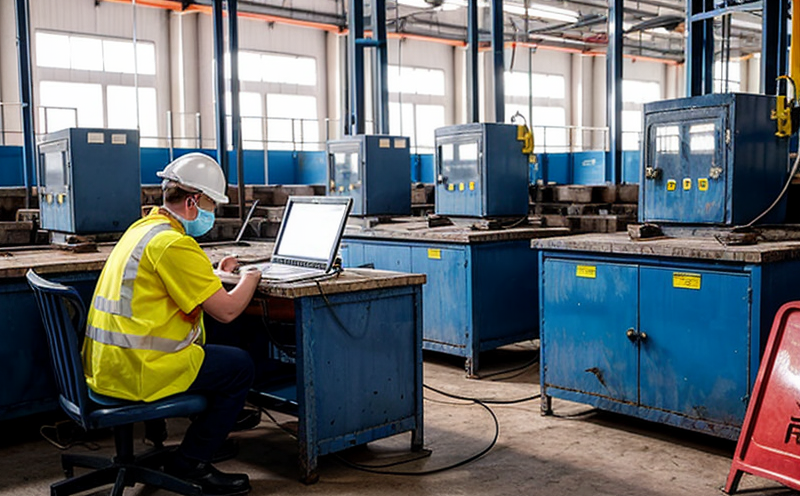ISO 13857 Safety Distance Testing for Machine Guards
The ISO 13857 safety distance standard is a crucial requirement for ensuring the safe operation of machines within industrial manufacturing and processing environments. This standard focuses on the protection of workers from potential hazards that can arise when operating machinery. The primary goal is to maintain an adequate safety distance between personnel and moving parts, thereby reducing the risk of injury.
Compliance with ISO 13857 is mandatory for industries where machinery poses significant risks to employees, including but not limited to automotive manufacturing, metalworking, woodworking, and packaging. Failure to adhere to this standard can lead to serious injuries or fatalities. Consequently, organizations must prioritize the implementation of robust safety measures to safeguard workers.
The testing process involves several critical steps that ensure the efficacy of machine guards in preventing accidents. These include:
- Identification of potential hazards
- Detailed risk assessment of machinery operations
- Design and installation of appropriate guards
- Testing to confirm compliance with ISO 13857 standards
The testing itself is conducted using specialized equipment designed to simulate real-world operational conditions. This allows for accurate measurement of the safety distance, ensuring that it meets the required thresholds specified in the standard.
| Test Parameter | Standard Value | Description |
|---|---|---|
| Safety Distance | ≥1.5 meters for rotating parts | The minimum distance between the operator and moving elements. |
| Guard Type | Belt guard, pulley guard | Type of guards tested to ensure they meet safety requirements. |
The testing process is both rigorous and comprehensive. It involves meticulous preparation of the machinery under test, ensuring that it operates in a manner closest to real-world usage scenarios. This includes adjusting parameters such as speed, load, and material type. The results are then analyzed against internationally recognized standards like ISO 13857, ASTM E2047, EN 953, and IEC 60204-1.
Once testing is complete, a detailed report is generated summarizing the findings and recommendations for any necessary adjustments or improvements. This document serves as evidence of compliance with industry best practices and ensures that all safety measures are up-to-date.
Scope and Methodology
| Test Parameter | Standard Value | Description |
|---|---|---|
| Safety Distance | ≥1.5 meters for rotating parts | The minimum distance between the operator and moving elements. |
| Guard Type | Belt guard, pulley guard | Type of guards tested to ensure they meet safety requirements. |
The methodology for ISO 13857 testing is designed to provide a standardized approach to evaluating machine guards. The process begins with the identification of potential hazards, followed by a detailed risk assessment. Once these steps are completed, appropriate safety measures are implemented and tested using precise instrumentation.
The testing itself involves simulating real-world operational conditions to ensure that the machine guards perform as expected under various scenarios. This includes adjusting parameters such as speed, load, and material type. The results of each test are meticulously recorded and compared against internationally recognized standards like ISO 13857, ASTM E2047, EN 953, and IEC 60204-1.
After completing the testing process, a comprehensive report is prepared detailing the results and any recommendations for improvement. This document serves as proof of compliance with industry best practices and ensures that all safety measures are up-to-date.
Benefits
The implementation of ISO 13857 safety distance testing offers numerous benefits to industrial manufacturing and processing facilities. By adhering to this standard, organizations can significantly reduce the risk of accidents and injuries associated with machinery operation.
- Enhanced worker safety
- Compliance with international standards
- Reduction in insurance costs
- Potential for regulatory compliance incentives
- Improved reputation and public image
- Increased operational efficiency by minimizing downtime due to accidents
In addition to these tangible benefits, adopting ISO 13857 testing also contributes to a culture of safety within the organization. This can lead to higher employee morale and satisfaction, as workers feel safer in their working environment.
Competitive Advantage and Market Impact
- Enhanced reputation and trust among clients and stakeholders
- Attracting top talent with a focus on safety and compliance
- Demonstration of commitment to sustainability through reduced accidents
- Potential for cost savings due to lower insurance premiums
- Increased operational efficiency by minimizing downtime
By implementing ISO 13857 safety distance testing, organizations gain a significant competitive advantage in the market. This is particularly true in industries where worker safety is paramount and regulatory compliance is non-negotiable.





